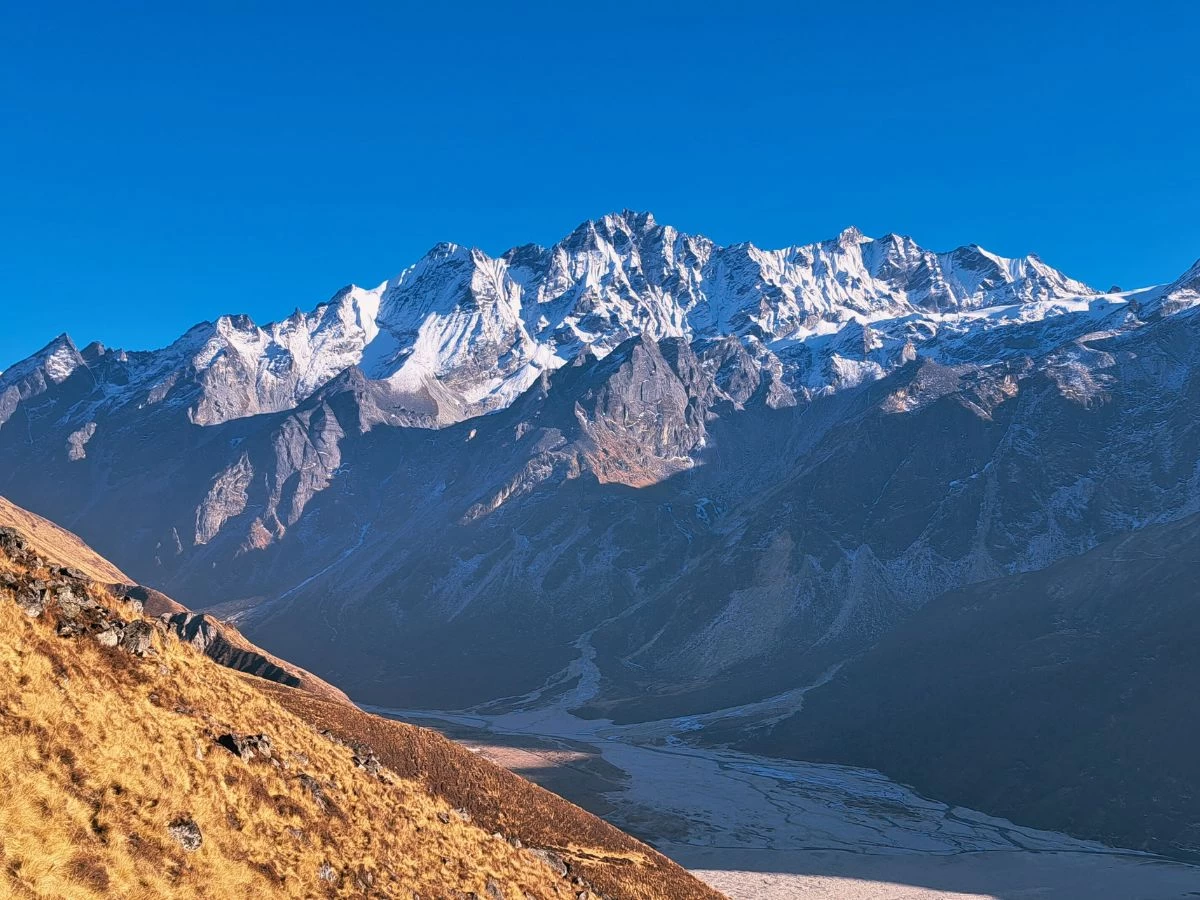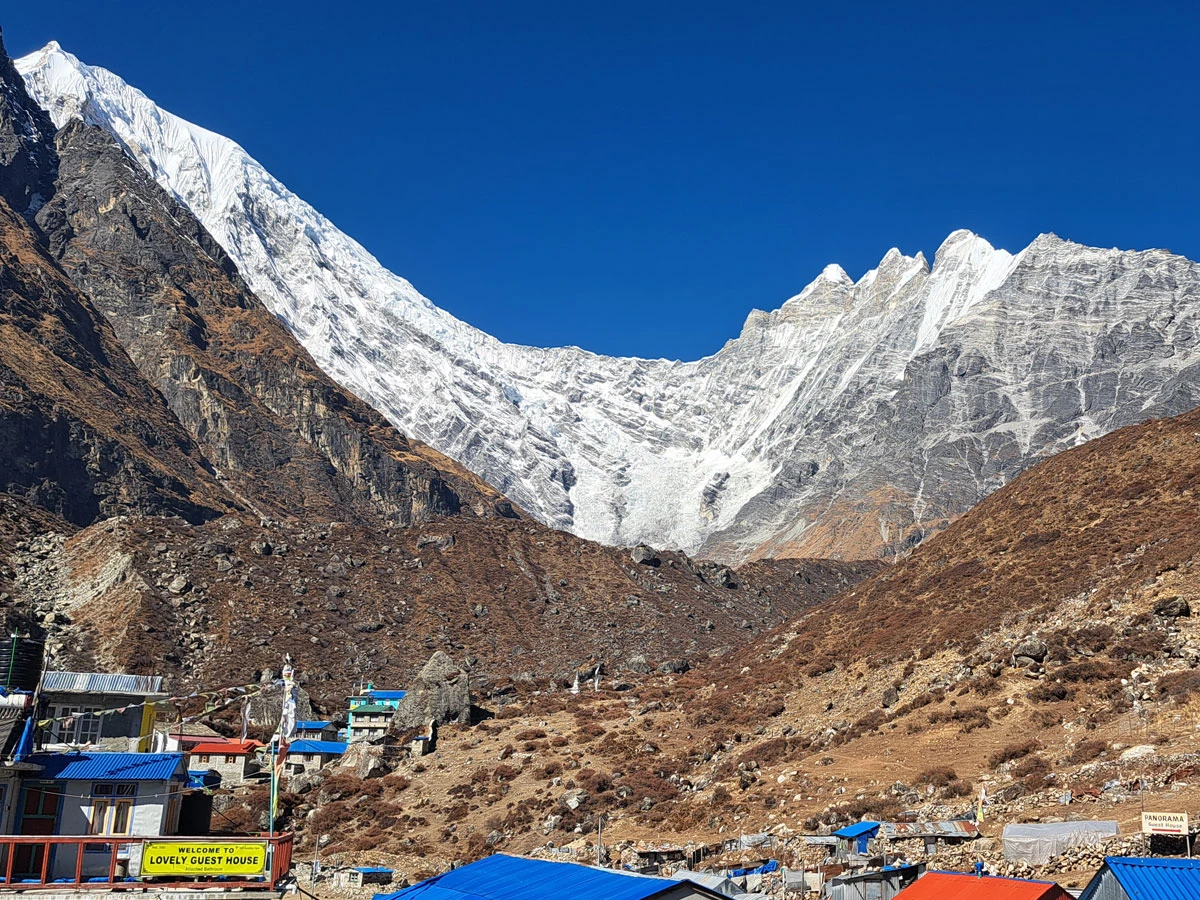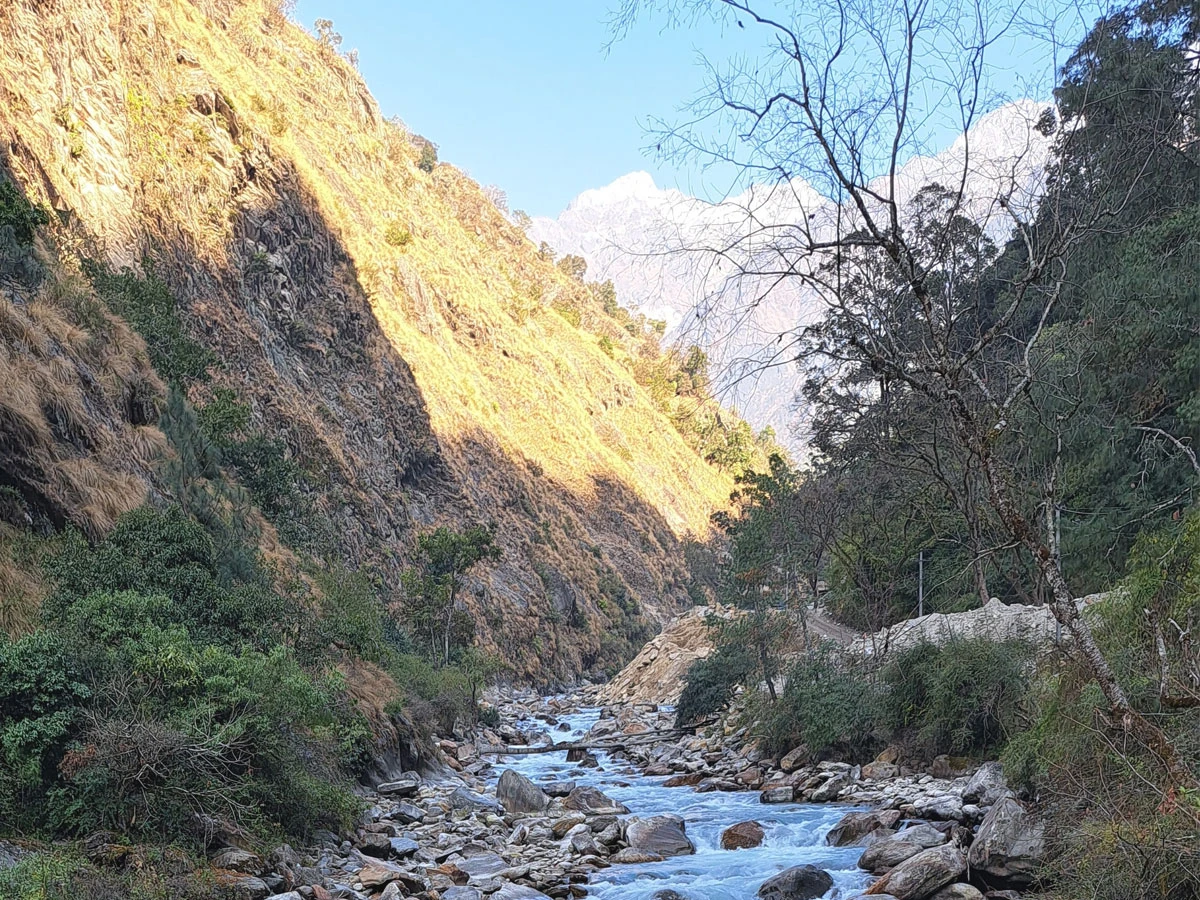If you're seeking a short trek in Nepal, breathtaking mountain views, a rich indigenous culture, and an opportunity to explore incredible wildlife, the Langtang Valley trek is an excellent choice. This trek is conveniently connected to Kathmandu, the capital city of Nepal. Unlike treks to Lukla in the Everest region and Jomsom in the Annapurna region, you won't have to worry as much about local flight cancellations.
Langtang Valley Trek- 10 Days
Trip Overviews
The 10-day Langtang Valley trek is a breathtaking adventure in the Langtang trekking region of Nepal, located north of Kathmandu near the Tibetan border. This trek is renowned for its stunning alpine landscapes, vibrant indigenous cultures, including the Tamang, Sherpa, and Tibetan communities, and less crowded trails compared to other popular trekking areas in Nepal, such as Everest Base Camp and Annapurna Base Camp.
The Langtang Valley Trek is perfect for those seeking beauty and authenticity in a tranquil setting, surrounded by the rich flora and fauna of Langtang National Park, which is famous for bird-watching and wildlife research. While this trek does not require peak physical fitness, having a moderate level of fitness will enhance your experience.
Highlights of the trek include stunning 360-degree mountain views from Kyanjin Ri and Tserku Ri, which reach an elevation of 4,984 meters.
If you’re looking for a short and moderate trek in Nepal, want to take in breathtaking mountain vistas, and wish to immerse yourself in the rich local culture, the vibrant Langtang trekking region offers an exceptional experience. Our 10-day Langtang Valley Trek is an ideal choice, providing excellent hospitality and services at a very reasonable cost while we explore the mystic and mythical sites of the Langtang Trekking Region.
What Makes the Langtang Valley Trek Special for 2025/2026?
The Trek Route Plans:
The Langtang Valley Trek is a remarkable destination that offers breathtaking views of stunning peaks while providing a delightful journey through the beautiful Langtang Valley. This trek is an excellent opportunity to explore the Langtang glacier, visit the Langtang Lirung base camp, climb Yala Peak, and experience diverse landscapes. Along the way, you'll encounter wildlife, renovated villages, an ancient Buddhist monastery, and a local Yak cheese factory, all set against the backdrop of magnificent mountains and extraordinary scenery.
The trek also highlights Langtang Lirung, one of the majestic peaks in the region, and allows you to discover the unique culture of the Tamang ethnic group, enhancing the authenticity of your experience. The 10-day Short Langtang Trek promises captivating views of grand mountains and a joyful trek through the stunning valleys.
The 8-day Langtang Valley trek begins and ends in either Syabrubeshi or Dhunche. To reach the starting point, travelers can take a 6 – 7 hour bus ride from Kathmandu, as there are no airports in the area. The trek itinerary, organized by Nepal Spirit Adventure, spans 6 days and includes the following stops: Syabrubeshi, Dovan, Pahiro, Bambo, Lama Hotel, Riverside, Ghoda Tabela, Gumba Danda, Langtang Village, Mundo Village, and Kyanjin Gompa.
Langtang National Park (Buffer Zone):
Langtang National Park serves to conserve rare animals and plants, which can be explored through the Langtang Valley Trek. Established in 1976, the park covers an area of 1,710 square kilometers, including a buffer zone of 420 square kilometers. Visitors can witness a diverse range of flora and fauna. Trekking in the remote areas of Langtang helps alleviate stress and brings a sense of happiness. This experience is truly remarkable.
Authentic Meals, Hospitality, and Accommodation:
Despite its remoteness, the valley offers suitable accommodation that features typical Nepalese food. The local people may not be as outgoing as those in urban areas, but they are humble and eager to engage in conversation. Their hospitality is warm and welcoming.
In the Langtang region, accommodations are generally basic, with twin-sharing beds available. Each tea house includes a warm dining hall and cozy rooms. Some accommodations along the trail provide en-suite bathrooms, but showers are not permitted inside the rooms.
During peak season, it is essential to book your accommodation at least a week in advance.
Enthralling Tamang Culture and Festivals:
In the Langtang Region, over 80% of the population belongs to the Tamang ethnic group. They boast a rich tradition and a unique culture, which includes a distinct language, traditional attire, writing system, ethnic musical instruments, and social customs. The Tamang caste consists of more than 120 sub-clans. Approximately 80% of the Tamang people practice Buddhism. Their language, known as Tamang, is part of the Tamangic branch of the Tibeto-Burman language family and is 75% similar to the Gurung language.
Two significant musical instruments for the Tamang people are the Damphu and the Cello. Tamang Cello songs often express humor, satire, joy, and sorrow, featuring brisk movements and rhythmic beats characteristic of the Tamang culture. The major festival celebrated by the Tamangs is Sonam Lhochhar, which takes place in the month of Magh (February-March). This festival marks the arrival of the Tamang New Year.
Breathtaking Panorama Scenarios:
Throughout the journey, you will pass through lightly populated and remote areas. However, the mesmerizing views of Ganesh Himal, Langtang Lirung (7324 m), Dorje Lhakpa (6966 m), Gangchempo (Langtang Ri 7205 m), Porong Ri (7292 m), and Yala Peak (5520 m) will make your heart race. Additionally, the stunning vistas of the glacier moraine to the north offer a spectacular view of Langtang Lirung rising majestically against the crystal-clear sky.
Kyanjin Gompa (3870m):
Kyanjin Gompa is home to ancient Buddhist monasteries and a small local cheese factory in Kyanjin village. It is known for producing some of the best hygienic Yak cheese available in the Langtang area. Visitors can learn about the socio-economic life of the locals, and interacting with the community and taking photos of their children can make the trek even more memorable. Kyanjin Gompa is the last teahouse on the Langtang Valley Trek, making it an excellent spot to explore the beauty of the surrounding hidden nature.
A Lovely Day Hike to Tserku Ri Viewpoint (4984 m):
When trekking to Langtang Valley, be sure to include a hike to the stunning Tserku Ri viewpoint. This location offers breathtaking views of the enchanting Langtang Himalayas as well as the Tibetan Himalayan range. From here, you can see the world’s 14th-highest peak, Mt. Shishapangma, which stands at 8027 m, providing an incredible panorama.
A day hike to Tserku Ri is more challenging than the previous days, as it requires climbing nearly 1100 m from Kyanjin Gompa.
Sacred Gosainkunda Lakes (4,380 Metres)
One of the main reasons people trek to the Langtang region is to visit the holy Gosainkunda Lake. Situated at the top of a hill, the lake often freezes during the winter, and many trekkers enjoy skating on its surface, which is a truly remarkable experience. This is one of the most attractive aspects of the Langtang region. There are a total of 108 lakes in the area, but the most fascinating and popular ones are Saraswati Kunda, Bhairab Kunda, Surya Kunda, Naga Kunda, and Gosainkunda.
Additionally, the pristine Gosainkunda Lake is revered by both Hindu and Buddhist devotees during special occasions. The combination of the Tamang Heritage Trail with the Langtang Valley trek offers the best opportunity to explore the rich religion, culture, and festivals of the Langtang Valley.
Low Altitude and Short Treks in the Langtang Region
If you are not an extreme adventure seeker, the trekking routes in the Langtang region offer a great opportunity for hiking and enjoying spectacular mountain views. This area features a variety of treks, allowing you to choose one that suits your preferences. All of these treks are set at low altitudes, making them accessible for everyone to complete while enjoying the beauty of nature. Most treks can be finished within a week, and they are considered some of the most reliable trekking options in Nepal.
Alternative and Reliable Langtang Area Trek
The Langtang Trekking Region is one of the most reliable and popular trekking destinations in Nepal. It is easily accessible and offers breathtaking views of the Langtang Valley's flora and fauna. Treks can begin from various starting points, including Syabru Bensi, Dhunche, and Sundarijal. The primary mode of transportation to these locations is by road, but if you prefer, you can also opt for more luxurious travel options.
Family Easy Trekking Route, Beyond Kathmandu
Explore the breathtaking beauty of the Himalayas with your kids. Trekking with children can be challenging, as you need to consider several factors such as altitude, walking hours, and distance. Fortunately, the Langtang Valley Trek is a suitable option. The trail is easy to navigate, and the distance between teahouses is relatively short, making it an ideal trekking destination for families. Many families are choosing this trail for their trekking adventures.
Connection with Other Trekking Trails
The Langtang trekking route is one of the major assets of the Nepal tourism sector. The Langtang Valley trekking trail serves as an excellent starting point for various side trips, including the Tamang Heritage Trail, Langtang Valley and Ganjala Pass Trek, Helambu Circuit Trek, Pangsang Pass with Ruby Valley Trek, Gosainkunda Pass Trek, and the popular Gosainkunda Lake Trek, known for its sacred holy lake.
For the years 2025 and 2026, you can find a variety of trekking packages in the Langtang Region. We can customize the itinerary and budget based on your physical fitness level, preferred holiday length, and specific preferences.
Off The Beaten Trail in Langatng Valley Trek
Embark on an exhilarating journey to the Langtang Valley with Nepal Spirit Adventure. The 10-day trek itinerary is a captivating adventure that takes you into the heart of the Langtang Trekking Region, a trendy Indigenous village nestled in the majestic Himalayas of Nepal. The trek perfectly blends natural beauty, cultural encounters, and panoramic mountain views. As you hike through the picturesque landscapes, you will witness awe-inspiring snow-capped peaks, lush forests, serene rivers, and charming villages.
During the trip, you will explore the enchanting Langtang Valley, visit the sacred Kyanjin Gompa Monastery, and be captivated by the breathtaking views of Langtang Lirung, Ganesh Himal, and other neighboring peaks. The trail will take you through quaint villages like Syabrubesi, Lama Hotel, and Ghoda Tabela, where you can interact with the warm-hearted locals and experience their way of life.
The Langtang Valley Trek is a perfect choice for both novice and experienced trekkers, offering a rewarding experience in a relatively shorter duration. It is an opportunity to rejuvenate your mind, body, and soul in the tranquil surroundings of the Langtang region. Join Nepal Spirit Adventure on this remarkable journey to the Langtang Valley and create memories that will last a lifetime. Let us be your trusted guide as you explore the natural wonders and cultural treasures of this spectacular region.
Langtang Valley Trek Highlights:
- Kyanjin Ri and Tserku Ri offer breathtaking 360-degree mountain views
- Explore Indigenous villages & Tibetan cultural heritage
- Trek through the picturesque Langtang Valley
- Visit the sacred Kyanjin Gompa monastery
- Breathtaking views of Langtang Lirung, Ganesh Himal, and neighboring peaks
- Explore charming villages like Syabrubesi, Lama Hotel, and Ghoda Tabela
- Experience the warm hospitality of the mountain communities
- Witness rich biodiversity and rare flora and fauna
- Enjoy delicious local cuisine in comfortable teahouses
- Suitable for both novice and experienced trekkers
- An easy and short trek accessible from Kathmandu
- Immerse yourself in the tranquil surroundings of the Langtang region
When to Trek in the Langtang Valley?
The ideal time to trek in the Langtang Valley is during the dry season, which lasts from October to May. The least favorable time to trek is during the monsoon season, from June to September. In Nepal, the dry seasons are spring (March to May) and autumn (September to November). It is advisable to avoid the monsoon season due to the various risks associated with trekking during this time.
Autumn Season (September to December)
The first three months of the dry season, from mid-September to mid-December, provide the best weather for trekking in the Langtang (Himalayas) Valley of Nepal. After the monsoon rains, the air is crystal clear, the mountain scenery is stunning, and temperatures remain comfortably warm. While December, January, and February are still suitable for trekking, they can be too cold and icy for comfort. The Langtang treks are consistently popular and have a low risk of altitude sickness, although they can be challenging.
Spring Season (February to May)
From March to May, the weather tends to be dry for an extended period, leading to dust particles hanging in the air, which can affect visibility. However, spring is the ideal time to enjoy stunning mountain vistas and the vibrant greenery of blooming forests. We highly recommend both the autumn and spring seasons for hiking, trekking, and climbing in Nepal..
Getting there: Route Overview
The Langtang Valley Trek begins with a scenic drive from Kathmandu to Syabrubesi, a vibrant village at the gateway of the Langtang region. From Syabrubesi, we start our trek, following the trail along the Langtang Khola River. The route takes us through beautiful forests of rhododendrons, bamboo, and pine trees, offering glimpses of diverse wildlife and bird species. As we ascend, we pass through charming villages like Lama Hotel, Ghoda Tabela, and Langtang Village, where we can immerse ourselves in the local culture and interact with friendly people.
Continuing our trek, we reach Kyanjin Gompa, a sacred monastery situated at the base of Langtang Lirung. Here, we can explore the monastery, enjoy panoramic mountain views, and soak in the serene atmosphere. After spending time in Kyanjin Gompa, we retraced our steps back to Syabrubesi, enjoying the scenic landscapes, and bid farewell to the Langtang Valley. Finally, we drive back to Kathmandu, concluding our memorable Langtang Valley Trek.
Variation
If you have more time, this trek combines well with the nearby Tamang Heritage Trail, which adds an extra 4-6 days of trekking. You will learn more about the ethnic Tamang people, who originally came from Tibet.
Alternatively, a trekking route is also available: trek over the Gosainkunda Lake Pass back to Kathmandu instead of driving. Gosainkund is a beautiful blue high-altitude lake. It is preferable to trek to Gosainkunda on the return from Langtang rather than on the way, as it requires a fairly steep ascent. By this point, you will be better acclimatized, making the height of the lake (4,380 m.) less of a concern.
If trekking this route without a guide, be especially careful with the altitude—numerous people have been caught out by a dangerous error in a commonly available trekking map that incorrectly lists some altitudes. Double-check all altitudes before setting off.
What Kinds of Meals & Accommodation do we expect?
The Langtang Valley had been very well set up with plenty of comfortable lodges. While the earthquake and landslide destroyed many in certain towns (most dramatically, Langtang Village), plenty of other settlements were less affected, and good options are still plentiful.
The standard here is good, with warm blankets, fireplaces, comfortable beds, the occasional hot shower (for an extra fee), and a variety of food. Don’t forget to try the momos in this region, as they are larger and more pastry-like than those commonly found in the capital.
Langtang Valley Trek Route Permit:
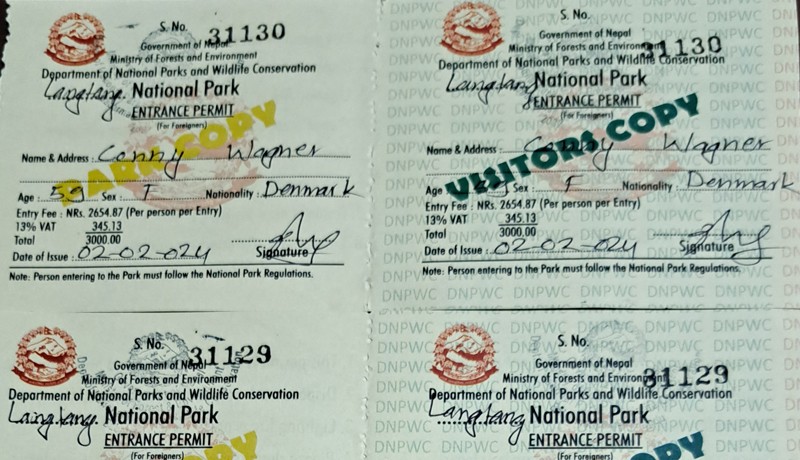
Trekking route permit for the Langtang Valley Indigenous area
When you are ready to do the Langtang Valley Trek booking with Nepal Spirit Adventure, the trek route permit is compulsory for all trekkers; you’ll need a TIMS card (US$16) and a Langtang National Park permit (US$23). This permit fee is included in the trek package prices and is required at checkpoints along the route of Langtang Valley.
Trip Gallery
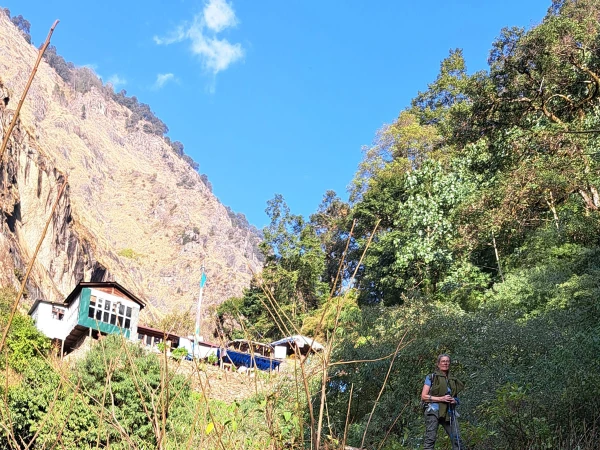
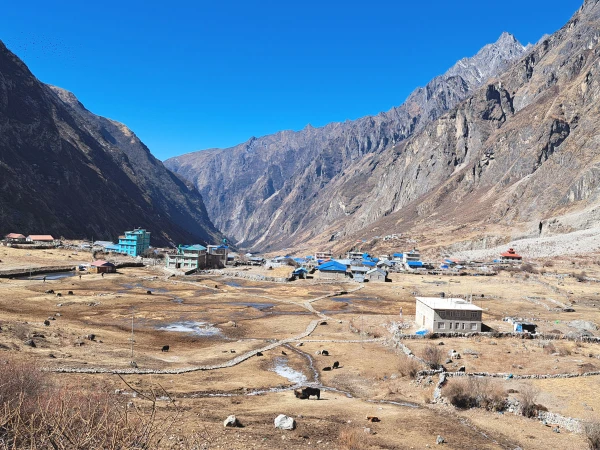
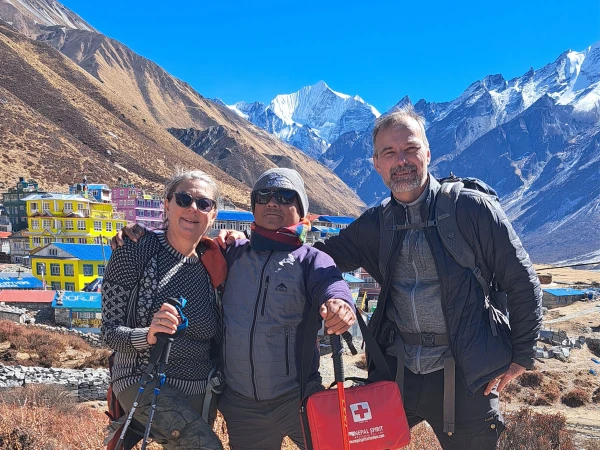
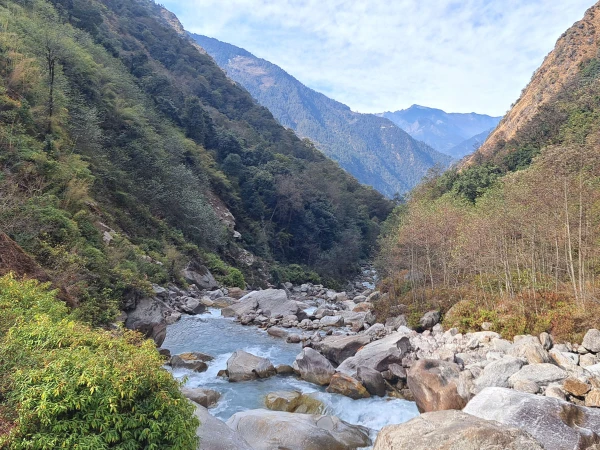
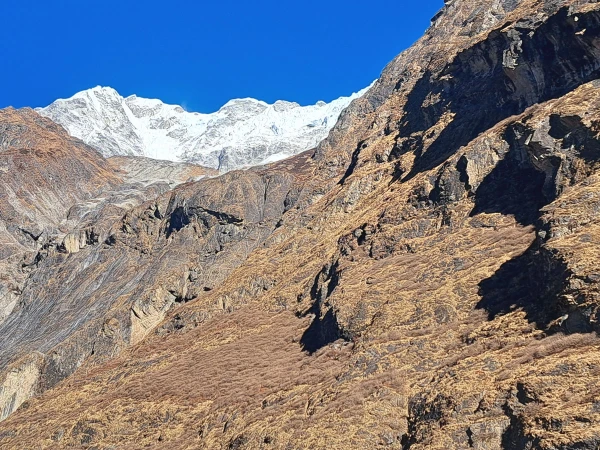
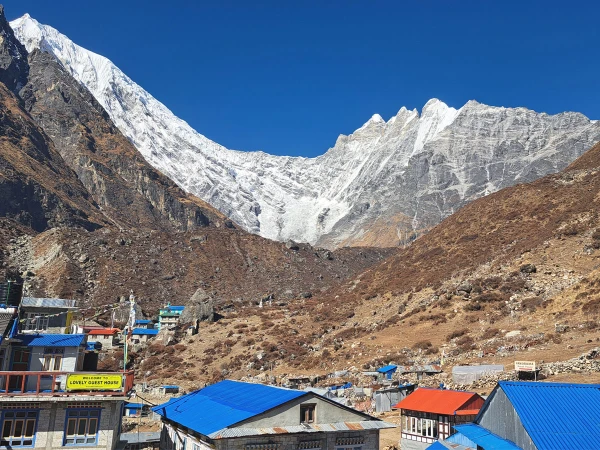


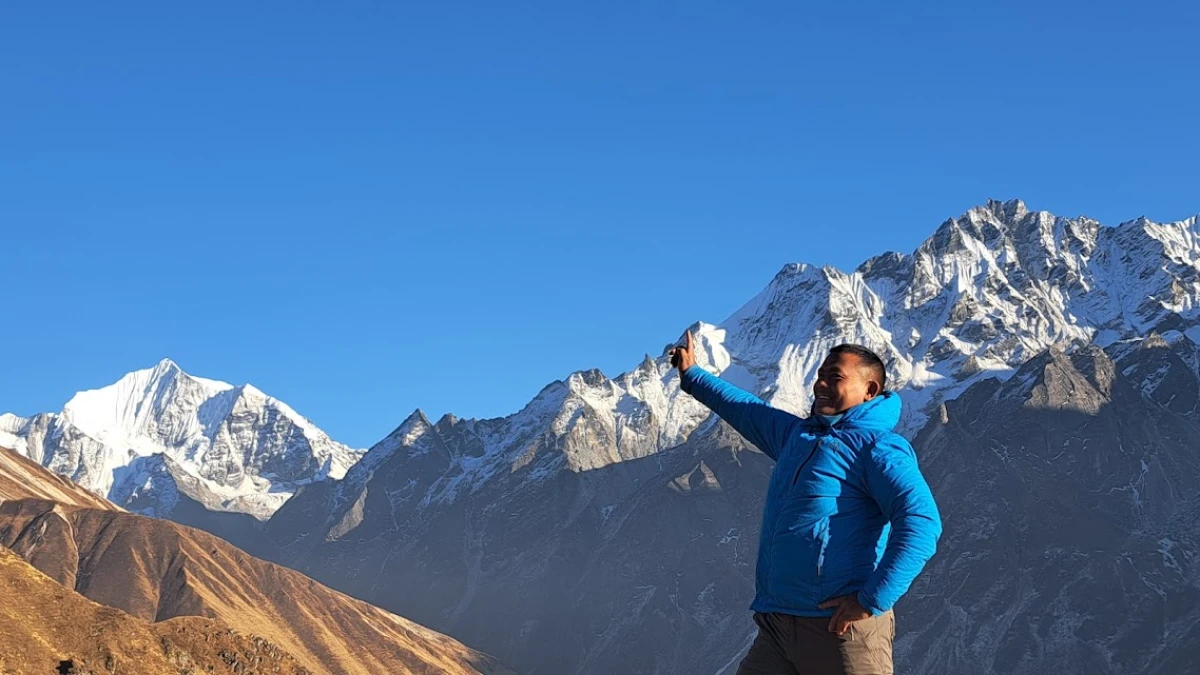
Short Itinerary
Arrive in Kathmandu, Airport Pickup, Transfer to Hotel
From Kathmandu to Syabrubesi by Bus Approx. 6-7hrs
Syabru to Lama Hotel Approx. 5 Trek
Trek to Langtang Village, Approx. 6hrs
Approx. 4 hours trek to Kyanjin Gompa
Climb Tserku Ri (5,033m), Approx. 7hrs Trek Or Kyanjin Ri
Kyanjing Gompa to Lama Hotel Approx.6/7hrs Trek
Trek back to Syabrubeshi , Approx. 6hrs
Bus Drive back to Kathmandu 6/7hrs -122 km
Departure ( End of Trek)
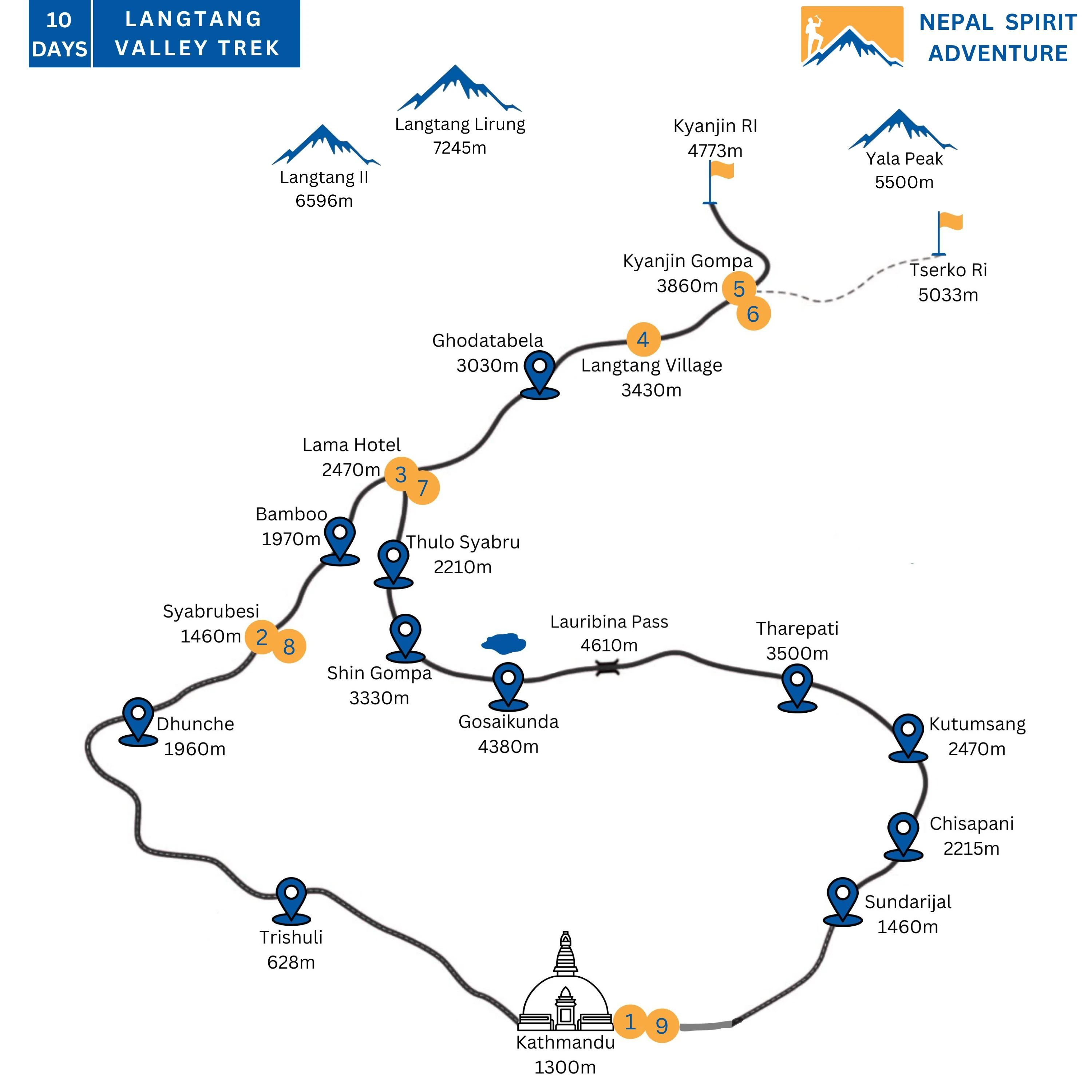
Langtang Valley Trek- 10 Days Itinerary
The Langtang Valley Trek itinerary spans 10 days, starting and ending in Kathmandu, which includes your international arrival and departure. Our trek itinerary is flexible, allowing us to customize it to fit your specific holiday needs in Nepal.
Arrive in Kathmandu, Airport Pickup, Transfer to Hotel
After landing at Tribhuvan International Airport in Kathmandu, our airport representatives will meet you and arrange a short drive to your hotel in the heart of the city. Once you check into your comfortable room and take some time to rest and recover from any jet lag, you will have the chance to meet another group member from the Langtang Valley Trek.
Our guide will provide you with important information about the trek to Langtang Valley, details about our services, and we will review the trek equipment. You’ll spend the night in Kathmandu, preparing for the adventure ahead.
From Kathmandu to Syabrubesi by Bus Approx. 6-7hrs
Embark on a marvelous journey to Langtang Valley with an early morning scenic drive from Kathmandu to Syabru Besi, a Tamang village in the Rasuwa district of the Langtang area. The drive takes you north, passing through interesting towns and farmland, as you ascend towards the cooler environment above the mid-hills, leaving behind the lowland rice terraces.
Upon reaching the entrance of Langtang National Park in Dhunche (1,965 m), a major town in the Langtang area, you will make a brief stop before continuing downhill to our first overnight destination at Syabru Besi village, a remote location with cozy lodges.
The standard service includes transportation by bus, lunch, dinner, and lodging.
Syabru to Lama Hotel Approx. 5 Trek
The first day of our trek begins with a climb that lasts a few hours, followed by a gradual walk through terraced farms and scattered villages. As we continue, we reach a riverside where the trail from Thulo Syabru meets several teahouses and lodges. After a short rest, we will walk uphill through serene forested areas filled with tall rhododendron, oak, and pine trees. This path leads us into a river gorge as we follow the Trisuli River upstream to the Lama Hotel, where we will stop for the night.
The standard service includes breakfast, lunch, dinner, and lodge accommodations.
Trek to Langtang Village, Approx. 6hrs
After a pleasant morning accompanied by the sound of the flowing river, the trek leads into a river gorge surrounded by dense woodlands. Along the way, you will pass a few small settlements and farms. The midday walk takes you to Ghoretabla, which means "Horse-Stable" in Nepali. After a nice break or lunch stop, the afternoon trek continues towards our overnight destination at Langtang Village, requiring a few more hours of moderate walking from Ghoretabla.
Langtang Village is a moderately sized settlement inhabited by the Bhotia and Tamang peoples, who have been the natives of the Langtang region for hundreds of years. The surrounding villages were devastated by avalanches as a result of the significant earthquakes on April 25 and May 12, 2015, but they are slowly returning to normal life.
Standard services include breakfast, lunch, dinner, and lodge accommodations.
Approx. 4 hours trek to Kyanjin Gompa
Today's trek to Kyanjin Gompa will take just a few hours. The walk begins with a short, steep climb after leaving the tree line and the river gorge. As you ascend, you will encounter short bushes of azalea (also known as bush rhododendron), juniper, and prickly barberry. After this climb, the trail opens into a wide path along the glacial valley, offering splendid views of the snow-capped mountains, including Dorji Lakpa, Langtang Lirung, Tserko Ri, Langshisa, and Naya Kanga (or Ganja La Peak).
As you reach Kyanjin Gompa, you'll discover a beautiful area with a wide valley and stunning views of the Langtang Lirung glacier and nearby icefalls, located just next to the lodges. Kyanjin is home to an old monastery situated on a rocky moraine ridge. The Langtang Valley features extensive grazing areas for yaks and is also known for its Yak Cheese Factory, established over three decades ago with Swiss assistance.
The standard service includes breakfast, lunch, dinner, and lodge accommodations.
Climb Tserku Ri (5,033m), Approx. 7hrs Trek Or Kyanjin Ri
Important Day of the Langtang Valley Trek
After waking up early in the morning, you’ll ascend to Tserko Ri (5,033 m), the highest point accessible from Kyangjin Gompa. This challenging hike takes you to an elevation where altitude sickness can become a concern. It’s important to take steady steps, breathe deeply, and stay hydrated throughout the trek, from the top offers 360% stunning mountain views.
Our trail will take us past the Langtang Lirung Glacier, providing fantastic views of the towering Langtang Lirung peak. At the summit, you’ll be treated to stunning panoramic views of Langshisa Ri, Kimsung, Changbu, Langtang Lirung, Dorje Lakpa, and Yala peaks.
If you prefer a gentle option, you can hike to Kyangjin Ri or Langshisa Kharka instead. These alternatives offer beautiful scenery without the extreme altitude gain. The route will lead you past yak pastures and grassy meadows, all surrounded by soaring white peaks. At the end of your hike, you can take some pictures, enjoy the views, and then return to the village.
Mountain Views:
We can see the panoramic views of Chimsedang Lekh and Kangjal Himal, a ridge of peaks to the south of the valley. You'll also have stunning views of several significant mountains, including Naya Kanga (5,844m), Ganchenpo (6,387m), Dorje Lakpa (6,990m), Pemthang Karpo Ri (6,830m), and Langtang Lirung (7,245m). To the north, across the border in Tibet, stands the massive Shishapangma (8,046m), which is the 14th-highest mountain in the world.
The standard service includes breakfast, lunch, dinner, and lodge accommodations.
Kyanjing Gompa to Lama Hotel Approx.6/7hrs Trek
Long day trek, easy walking from a high-altitude place to a low-altitude place. Approximately a 21-kilometer trek from Kyanjin Gompa to Lama Hotel takes about 6-7 hours. Mountain views and the landscape are spectacular, and the trek follows back through the bank of the Langtang River.
After a delightful experience at Kyanjing Gompa in the Langtang Valley, the day begins with an extended trek that is significantly easier due to the mostly downhill route. The journey takes you through Langtang Village and Ghodatabela, following the path alongside the Langtang Khola. Enjoy pleasant walks through the refreshing forest before arriving back at the Lama Hotel for an overnight stay.
Standard services include breakfast, lunch, dinner, and lodge accommodations.
Trek back to Syabrubeshi , Approx. 6hrs
Your final day trek of Langtang Valley:
On the final day of the trek, you will journey down to Syabrubesi, the starting and ending point of the Langtang Valley Trek. It will be a long day of descent, passing through the small villages of Bamboo, Pahiro, and Domen, until you arrive back at the place where your mountain adventure began.
Your trekking journey through this remarkable Langtang Valley concludes here. After this trek, you will always be able to cherish memories of red pandas, ancient monasteries, and the towering Langtang Himal overnight in a hotel.
Bus Drive back to Kathmandu 6/7hrs -122 km
Approximately 122 kilometers (6-7 hours) by bus back to Kathmandu
The following morning, after enjoying your final breakfast in the hills of the Langtang region, an exciting drive begins as we ascend towards Dhunche town. This journey continues along a winding descent, leading you to the warmer environment of Trisuli Bazaar, before finally returning to Kathmandu after your remarkable trekking experience in the Langtang Valley. A transfer to your hotel will be arranged upon your arrival.
For those interested in extending their adventure, we can discuss options such as the Tamang Heritage Trail or the Gosainkunda Lake Trek during the journey.
Note: Do you prefer traveling by private vehicle? A private vehicle is available upon request.
Departure ( End of Trek)
Transfer to Tribhuvan International Airport for your departure. This day marks the end of your Langtang Valley Trek. After enjoying a unique experience in Nepal, it’s time to say goodbye to the friends and acquaintances you have made during this journey. Our driver will drop you off at Kathmandu Airport (TIA) a few hours before your flight.
If you’re interested in experiencing more Himalayan adventures, Bhutan Tour and Tour to Tibet, please get in touch with us. We will be more than happy to assist you in planning another unforgettable trip.
Cost Details
Includes
Accommodation in Kathmandu
- Two nights' hotel with breakfast included
- We provide the hotel's best location in the market, restaurant, and monuments
Transportation
- Airport arrival and departure by private vehicle (Tribhuvan Airport, Kathmandu)
- Kathmandu to Syabrubensi by bus (trek starts place)
- Syabrubensi to Kathmandu by bus (trek ends place)
Langtang Valley Trek Permit
- Langtang Valley trek permit
- TIMS cards
Food & Accommodation
- Twin shared room in a guesthouse/teahouse on trek
- 3 Meals a day (breakfast, lunch, and dinner)
- The meals are chosen from the menu
- 3 cups of tea/coffee (black)
- Seasonable fruits
Trek Guide and Porters
- Experience a local trek guide
- Trained-licensed trek guide
- Speak English
- Strong-friendly porters (one porter for two trekkers)
- Guide and porter food, accommodation, meals, salary, and insurance
Provided Trek Equipment
- Down sleeping bag
- Down jacket
- Duffel bag
- T-short
- Flesh Hat
- NOTE: Sleeping bag, down jacket, and duffel bag are to be returned after the trek
First Aid and Customer Service
- Provided general medicine as first aid
- The first aid is staff and guests (carried by the trek guide)
- You can ask any questions before and after trip booking
- Every day, PH calls a meeting with the trek guide (To know the trek condition)
Service Charge
- Government tax
- Applicable company and related taxes
- Company service charge
Excludes
International Airfare & Nepal Visa
- Your international flight to Kathmandu
- Nepal visa (you can get at arrival)
Personal Trek Equipment & Extra Expenses
- Personal trek equipment for Langtang Valley
- Travel insurance and rescue operation coverage
- Drinks beverages: Alcoholic and non-alcoholic drinks, including mineral water, Sprite, Coca-Cola, juice, extra tea, coffee, beer, whiskey, chocolate biscuits, and more.
- An extra night hotel in Kathmandu after the trek
- Tipping
Dates & Availability
Private TripThe online trek departure date is guaranteed to start the trip from Kathmandu. If the trip departure date does not match with your trek in Nepal holiday, feel free to contact us.
Essential Information
The expert team at Nepal Spirit Adventure is dedicated to ensuring that our clients' comfort and safety are our top priorities. We provide helpful information to assist you while booking your trek or tour with us. It’s important to have a clear understanding of various aspects such as accommodation, transportation, trek equipment, maps, food options, lodges during the trek, and more. Please review the following information to ensure a fulfilling experience on the Langtang trek. The trek itinerary begins in Kathmandu, the capital of Nepal.
Langtang Valley Trek’s Equipment Packing List
When booking a trek with us, we recommend that you pack according to the season, as different gear and clothing are needed for the Langtang Valley Trek. Below is a list of essential items we suggest you bring for your comfort. You can store any unnecessary items for free at the Nepal Spirit Adventure store or your hotel in Kathmandu. If you don't have the necessary gear, you can purchase it at reasonable prices upon your arrival in Kathmandu, Nepal.
According to our booking terms and conditions, we provide one porter for every two trekkers, and the luggage weight limit per trekker is between 10 to 13 kg. We suggest partnering with a fellow traveler and using a duffel bag provided by the company to pack your belongings. Additionally, please bring a regular backpack to carry your valuables and important documents during the trek to Langtang Valley.
Head:
- Sun hat or scarf
- Winter hat insulating hat, or a wide-brimmed hat
- Headlight with extra batteries
Face:
- Sunscreen
- Sunglasses with UV protection
- Face/body wipes
Hands:
- Lightweight gloves
- Heavyweight winter gloves
Body:
- Hiking shirts
- Long-sleeved shirt made of synthetic fiber
- Hooded rain jacket
- Fleece jacket
- Lightweight cotton pants
- T-Shirt (bring lightweight wool)
- Polypropylene underwear
- Down jacket (available for rent in Kathmandu)
- Sweater
- Waterproof jacket and pants
Footwear:
- Hiking Boots
- Thick wool socks (Take an extra pair of thick, light socks)
- Sandal
Essential Gear:
- Backpack or daypack (size depends on whether you take a porter or not)
- Thermal bottle
- Water purification
- Trekking pole
- Sleeping bag (-15 degree bag is best in the high altitude trek)
- Toiletries (toilet paper, toothpaste, toothbrush)
Personal Accessories:
- Money
- Watch
- Cell phone
- Camera
- Chocolate bar/biscuit
Extra Items:
- First aid kit
- Extra passport photos and passport photocopies
- Notebook and pen
- Binoculars
How can we get a Nepal visa?
# You can get a Nepal visa upon arrival at Kathmandu Tribhuwan International Airport. If you are traveling to Nepal by overland service, you can also get a visa for every border between Nepal, India, and China. You can also apply for the online visa service before arriving in Nepal.
Nepal Visa Fees: On-arrival visa fees at entry points
It is our pleasure to provide you with Nepal visa fees, which also don't include the travel. As per Nepal government rules following cost is for a Nepal Visa.
- 15 Days – 30 USD
- 30 Days – 50 USD
- 90 Days – 125 USD
What kind of health and fitness is required?
# Health and physical fitness are the most important part of travel and participating in trekking and hiking. If you do not have previous trekking experience as required, you can start with a morning walking exercise or cycling for weeks or months before/after booking the trip with us.
The highest height gain on this trip is at 3,910m/12,828ft. Above sea level, walking through local villages, farmlands, terraces, and the riverside as long as you have energy, walking for 5- 6 hours a day, and if you are qualified for the trek, but still require moderate health and fitness.
We strongly advise travelers to consult their medical doctor before traveling, do a regular check-up, and hand the report to us while booking a trip with us.
Can we charge our batteries with electricity?
# We can recharge your batteries and devices with electricity or solar power sources. In Nepal, 220- 240 volts 50 MHZ (50 Cycles per Second) power is supplied. Just need to have a (two-pin or 3-pin) plug adaptor in case of socket fitting, which you can buy in Kathmandu before the trip, since the plugs in Nepal might be different. You might have to pay a small amount of fee/hour for using the recharging facilities.
What Is the Condition of Altitude Sickness During the Langtang Valley Trek?
Altitude sickness, commonly referred to as acute mountain sickness (AMS), can occur when individuals ascend too quickly, particularly at elevations exceeding 3,000 meters. Most people will experience mild effects from the altitude, such as shortness of breath and occasional light-headedness, which are relatively common.
Acute mountain sickness, however, is a more severe condition that typically manifests as a severe headache, nausea, and confusion. Fortunately, there are often clear warning signs when symptoms of altitude sickness begin to appear. If you start to feel unwell, it’s important to inform your trekking guide right away; they will provide guidance on how to address the issue.
Exertion and dehydration are key factors that contribute to altitude sickness. To mitigate the risk, it is recommended to drink at least 3-4 liters of water each day in addition to tea and coffee, as these beverages can act as diuretics.
What Is You Group Size for Langtang Valley Trekking?
Our online departure dates are guaranteed for the Langtang Valley Trek schedule. We offer various trekking routes in Nepal with fixed departure dates or private trips. The minimum group size is two, while the maximum can be ten or more upon request.
We can also arrange a private trip for a solo traveler, subject to a single supplement cost. Alternatively, you can join one of our scheduled group departures available online, or you can contact us for flexible dates. We will accommodate your preferred departure date by opening new group dates as needed.
When Is The Best Time for the Langtang Valley trek?
The primary trekking seasons in the Langtang Valley are from March to May in spring and from September to December in autumn. During these periods, daytime temperatures are typically suitable for walking at most altitudes, the skies are mostly clear, and rain and snow occur infrequently. In the Kathmandu Valley, the capital of Nepal, daytime temperatures range from 15 to 35 degrees Celsius. At an elevation of 3,600 meters, temperatures are slightly lower and continue to decrease with altitude.
Post-Monsoon/Autumn: (Mid-September to November) These months represent the main trekking season in Nepal. Daytime temperatures in Kathmandu are generally above 20°C. The skies are usually clear, and the days are sunny, providing mild weather and stunning mountain views. However, nights can be quite cold, with temperatures dropping as low as -15°C at the highest altitudes.
Winter: (Last Week of December to the End of February)Despite cooler conditions, winter is an excellent time to trek in Nepal. The skies are typically very clear, especially in December, offering some of the best mountain views. Nights can be frigid, with temperatures ranging from -10°C to -15°C at the highest altitudes, but daytime temperatures are often pleasant and sunny. The trekking trails are also less crowded during this season, with maximum daytime temperatures in Kathmandu reaching around 23°C.
Pre-Monsoon/Spring: (March to May) During this time, both daytime and nighttime temperatures are generally warmer, but a haze may develop in the afternoons. It can be quite hot in the lowlands, with temperatures soaring to 35°C in Kathmandu. Spring is also known for its blooming flowers, which attract many tourists. Snow may be encountered during this season, particularly at higher altitudes.
Langtang Valley Trek- 10 Days FAQs
The Langtang Valley trek is situated north of Kathmandu, the capital city of Nepal. This trekking route is part of the Langtang Region, which is the third most popular trekking area in the Himalayas of Nepal.
The Langtang Valley Trek is an easy hike and cultural journey located in the Langtang region. This trek reaches a maximum elevation of 3,840 meters at Kyanjin Gumba. Overall, the Langtang trek is considered to be straightforward, making it suitable for those looking for a less challenging high-altitude experience in the Langtang area.
We start and end this adventure from Syabrubesi, which requires approximately a 6-7 hour bus drive from Kathmandu.
It is approximately 122 km away and takes about a 6-7 hour bus journey from Kathmandu to Syabrubesi.
The best time to go to the Langtang Valley is from September to May. The weather is usually stable from September to December, with mild to warm days and cold nights. February, March, April, May, June, October, November, and December are the best times to do this trek.
The weather in the mountains is often unpredictable. If you're not properly prepared for the sudden changes and variability of conditions in this stunning area, you might find yourself in an uncomfortable situation. Here are some essential weather basics to help you arrive in the Himalayas well-equipped and ready for anything.
Generally, nights are much cooler than daytime hours. Many first-time trekkers are surprised by the significant temperature variations that can occur within a single day. During the day, temperatures can rise as high as 25 degrees Celsius (77 degrees Fahrenheit), only to drop to -20 degrees Celsius (-4 degrees Fahrenheit) within 24 hours. While it is impossible to predict the exact weather for each day in the mountains, you can expect certain trends based on the month and season.
Spring – March / April / May-June:
Spring is one of the best times of the year to visit the Langtang region, although it can become somewhat crowded during this season. You'll enjoy beautiful, clear blue skies and a variety of blooming flowers.
During spring, the average temperature is around 20°C (68°F), with a maximum of 25°C (77°F) on sunny days. In the mornings and at night, particularly in areas above 4000 meters, temperatures can drop to a minimum of -15°C (5°F).
Monsoon – July / August
Travel during the monsoon season is generally not recommended, as it tends to rain at lower altitudes (below 3500 meters). In areas above 4000 meters, there is occasional rainfall, but it can also be dry. Very few people travel during this season. However, trekking during the monsoon has its advantages; the increased rainfall creates stunning views of waterfalls, and it's the best time to avoid crowds.
During the monsoon months, the average temperature is around 22°C (71.6°F), with a maximum of 30°C (86°F) on sunny days. In the mornings and at night, temperatures can drop to a minimum of -5°C (23°F) in areas above 4000 meters.
Autumn: September / October / November
Autumn in the Langtang region is a popular trekking season, similar to springtime, and is considered one of the best times to explore. During this period, you can enjoy the beauty of blooming flowers and clear blue skies, providing stunning views from nearly every angle.
The average temperature in the fall is around 17 degrees Celsius (62.6 degrees Fahrenheit), with maximum temperatures reaching 20 degrees Celsius (68 degrees Fahrenheit) on sunny days. In the mornings and at night, temperatures can drop to a minimum of -15 degrees Celsius (5 degrees Fahrenheit) in areas above 4,000 meters
Winter – December / January / February
Winter lasts from mid-December to mid-February. Despite the colder temperatures, many people choose to trek during this time due to the reduced crowds. Visibility is still decent, although foggy conditions are common, so it is advisable to allow for extra days in your itinerary.
During winter, the average temperature is about 10 degrees Celsius (50 degrees Fahrenheit), with maximum temperatures of 17 degrees Celsius (62.6 degrees Fahrenheit) on sunny days. However, it can drop to a minimum of -20 degrees Celsius (-4 degrees Fahrenheit) in the mornings and evenings at altitudes above 4,000 meters. Please note that the above temperatures are based on the exterior of guesthouses. There is no need to worry about the cold, as we provide sleeping bags and extra blankets to ensure our clients stay warm during their stay.
What Our Guests Say?
It was my first time trekking in Nepal with some friends from Australia. The weather was ideal, and we could see the mountain, Langtang National Park, Indigenous villages, and the river. Given that the walk to Langtang Valley is not...
The trip was easy and offered the best mountain view through Langtang National Park, which is good and accessible from Kathmandu and offers indigenous people a similar culture to Tibet. The walking route is comfortable and can accommodate every kind...
We have never been to Nepal and didn’t get enough information, there is such a beautiful place for a hiking holiday. We met Nepal Spirit Adventure through Google Hunt Mr. Ram suggested about short and easy trek to the Langtang...
